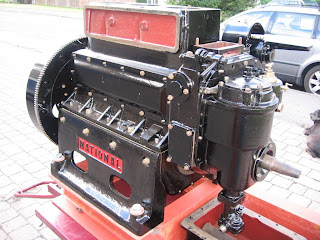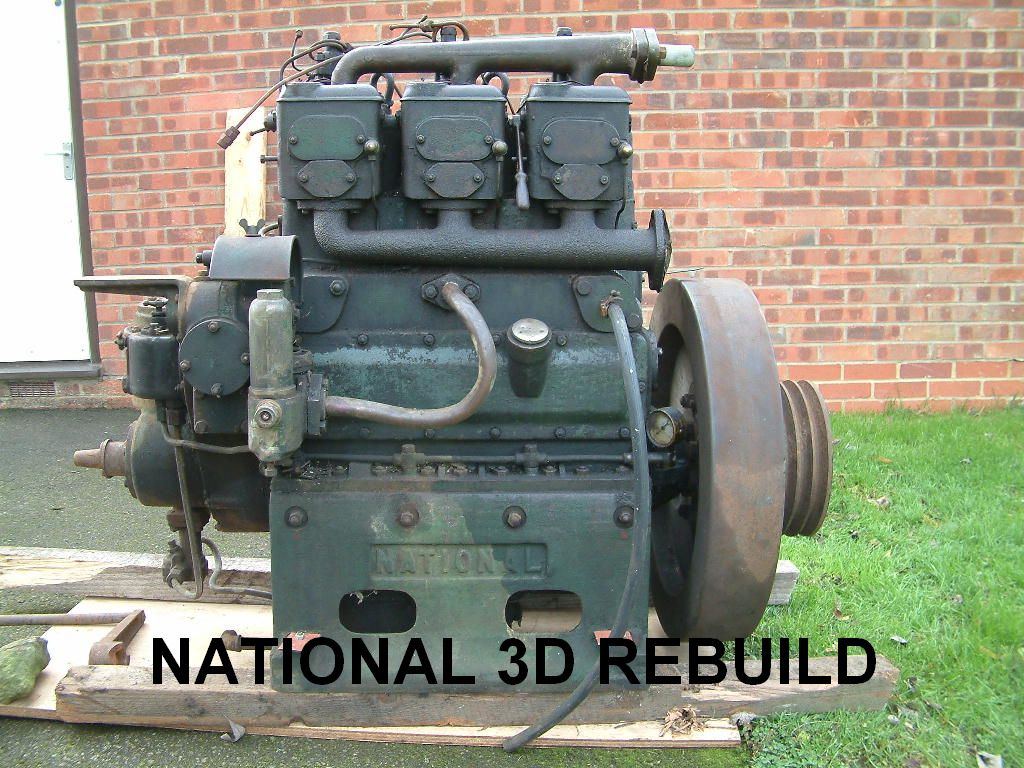Monday, 25 August 2008
NB Ocelot
My new Blog will be about the tours of the waterways on NB Ocelot. Reporting on the events, incidents and people I meet along the way.
http://nbocelot.blogspot.com/
I will, of course, continue to report on progress of the National. But there are a few things that need doing to Ocelot before the winter.
A Slight Pause



Saturday, 19 July 2008
Dry Build





Now, it's not time to get to excited as its all got to come apart again, but it does give an impression of the finished article.
I also now know of a few studs that need to be replaced and a couple of nuts that are missing. Additionally it has helped me find a few places (on the machines surfaces of the castings) that need to be painted before final assembly as they will be virtually impossible to get too once assembled.
A useful exercise and it does raise the level of hope!
Saturday, 5 July 2008
Engine Mounting and Bugger!
Well…. I made a decision about the mounting method and have gone for a modern product call ‘TICO S’. A "High performance machinery mounting pad", according to the manufacturers.
It comes in various guises, but I bought a strip of the stuff 100mm wide (4" in old money) by the standard 12.5mm deep. I also bought some of their TICO S washers.
The engine is to be mounted on the TICO strip and the bolts have TICO washers at the top of the engine. This has effectively cushioned the engine between the TICO material and should absorb a lot of the vibration but still hold it firmly to the engine bed.

Well… Whilst carrying out this exercise I noticed an error in the engine bed manufacturing process.
I welded the cross members between the longitudinal members at the engine mounting points. This would give the frame the most strength/rigidity at the mounting points. Fine at the front (this will be effectively covered by the flywheel overhang). A problem at the rear though.
The National has a sump that is separate to the crankcase. The clearance from the bottom of the crankcase to the top of the rear cross member is 4.1/4". What’s the depth of the sump?… 5.1/4" ……. Bugger!

I’ve now got to ‘notch’ out at least 1" from the top of the rear cross member. A bit of an exercise if the engine bed had been built of wood, but its not. It’s built from 6mm structural steel!
It’s been a while since I’ve used a gas axe. Man the fire extinguishers!
Still, at least I’m dealing with these problems in the comfort(?) of the garage. Imagine trying to do it having just lowered the engine in through the roof of your boat on to an engine bed that had just been welded to the bottom plate of your Narrowboat!
Happy days!
Flywheel
It's quiet a boring heading I know, but I have finally attacked the flywheel.
Originally the engine had an industrial flywheel (as can be seen on the blog header). This would have been a problem as it did not have any teeth for an electric starter (the engine being hand start only). However, a suitable toothed marine flywheel that matched the crankshaft mounting was supplied with the engine.
So, as per usual, the task in hand was to remove all of the paint back to bare metal.
How much paint can a flywheel have on it! There were layers of the stuff!
There's a lot more surface area to a flywheel than you think. Several tins of paint stripper and many hours with a wire brush and the thing was cleaned up.

Of course, once you get all of the old paint off and get the metalwork cleaned up, you've got to put the new stuff on. The result is:

A nice big black shiny flywheel!
Oh........ and another thing. The previous entry was with regard to the water pump. Well, here's a picci of the finished item assembled in full. I think it looks great against the black of the engine (the picci doesn't do it justice and it looks better in the flesh)

Thursday, 19 June 2008
Water Pump

A set of skew gears turns the drive through 90 degrees and operates a brass plunger via an eccentric cam.
All very simple but, hopefully, very effective.
Obviously the first thing to do was to break it down in to its component parts so that every thing can be inspected and cleaned up.
 In fairness, it was all in pretty good nick, so it then followed on with the usual (you know the score).
In fairness, it was all in pretty good nick, so it then followed on with the usual (you know the score).At the end of the task, another semi component is ready and wait for the great assembly process
 I love the cam lubrication process. Remove cover by undoing brass wing nut, open the spring loaded reservoir cap and fill reservoir with oil. A wick feed then drips the oil down on the the 'big-end' of the plunger and trough via an oil way to the 'little-end' of the plunger.
I love the cam lubrication process. Remove cover by undoing brass wing nut, open the spring loaded reservoir cap and fill reservoir with oil. A wick feed then drips the oil down on the the 'big-end' of the plunger and trough via an oil way to the 'little-end' of the plunger.Another little pre-start up job.

Next up, I intend to attack the flywheel. It shouldn't be to much trouble apart from the many layers of paint and the sheer weight of the thing and the associated problems that that brings with it.
Monday, 26 May 2008
Governor Case Re-build

The large section at the top housed a set of spring loaded centrifugal weights and the shaft drives the oil pump at the bottom.
Obviously the first job was to strip it down in to its component parts. Then the usual cleaning up, etc, etc. Eventually it turns in to this:

 Once everything was cleaned up, all of the various component part that required painting had an initial coat of paint. Then it was time to put everything back together.
Once everything was cleaned up, all of the various component part that required painting had an initial coat of paint. Then it was time to put everything back together.Ensuring the oil pump had the correct thickness of cover plate joint took a while. To thin and the gears were tight against the cover plate. To thick and there would be to much clearance between the cover plate and the gears which would result in a noisy and inefficient pump. The task was done by trial and error with multiple 0.5mm joints (all hand cut) until the correct thickness was achieved.
New joints where made for all of the other mating faces and, after a bit of fiddling around the final result:

Another bit ready to fit come the time of the great re-assembly.
